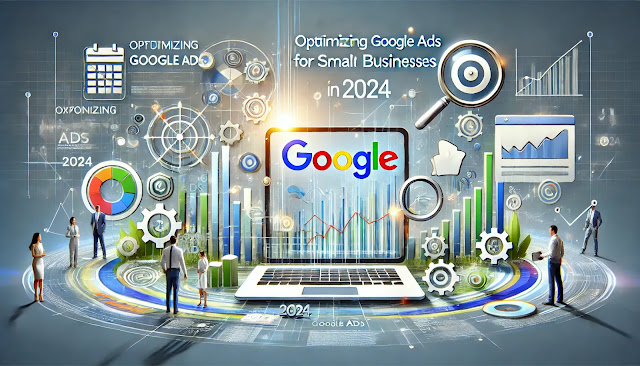Introduction
Google Ads continues to be a powerful tool for small businesses aiming to reach a wider audience and drive conversions. However, simply running ads is not enough; optimization is key to ensuring your campaigns deliver the best possible return on investment (ROI). In this post, we'll explore the top 10 Google Ads optimization tips for small businesses in 2024 to help you maximize your ad performance and achieve your business goals.
1. Keyword Research and Selection
Choosing the right keywords is fundamental to the success of your Google Ads campaigns. Here’s how you can optimize your keyword strategy:
- Tools for Keyword Research: Utilize tools like Google Keyword Planner, SEMrush, and Ahrefs to find relevant keywords that your target audience is searching for.
- Long-Tail Keywords: Focus on long-tail keywords that are less competitive but highly specific to your business. These keywords often have higher conversion rates as they cater to more specific search intents.
2. Ad Copy Optimization
Compelling ad copy can significantly improve your click-through rate (CTR) and conversions.
- Writing Effective Ad Copy: Ensure your ad copy is clear, concise, and highlights the unique benefits of your product or service.
- Strong Call-to-Action (CTA): Include a strong CTA that encourages users to take the desired action, such as “Buy Now,” “Sign Up Today,” or “Learn More.”
- Examples: Compare different versions of ad copy to see what resonates best with your audience.
3. Use of Ad Extensions
Ad extensions provide additional information and can enhance the visibility of your ads.
- Types of Ad Extensions: Use sitelink extensions, callout extensions, structured snippets, and more to provide extra value and encourage clicks.
- Improving Visibility and CTR: Ad extensions can improve your ad’s visibility on the search results page, leading to higher CTRs and better performance.
4. Landing Page Optimization
A high-quality landing page is crucial for converting ad clicks into customers.
- Improving Landing Page Speed: Ensure your landing page loads quickly to reduce bounce rates and improve user experience.
- Usability: Make your landing page user-friendly with a clear layout, easy navigation, and mobile optimization.
- Consistency: Ensure your landing page content matches your ad copy to provide a seamless user experience.
5. Audience Targeting
Targeting the right audience ensures your ads are seen by potential customers who are likely to convert.
- Demographic Targeting: Use demographic data to target specific age groups, genders, and household incomes.
- Custom Audiences and Remarketing: Create custom audiences based on user behavior and interests. Utilize remarketing lists to re-engage previous visitors.
- Geographic Targeting: Focus your ads on specific locations where your target audience is located.
6. A/B Testing
A/B testing allows you to compare different versions of your ads and landing pages to see which performs better.
- Setting Up A/B Tests: Use Google Ads’ built-in tools to create and run A/B tests.
- Elements to Test: Experiment with different headlines, descriptions, images, and CTAs to determine what resonates best with your audience.
7. Budget Management
Effective budget management ensures you’re getting the most out of your ad spend.
- Setting a Realistic Budget: Determine a daily or monthly budget based on your overall marketing spend and goals.
- Efficient Budget Allocation: Allocate more budget to high-performing ads and campaigns.
- Monitoring and Adjusting Budget: Regularly review your spending and make adjustments based on performance.
8. Conversion Tracking
Tracking conversions is essential for measuring the success of your campaigns.
- Setting Up Conversion Tracking: Implement conversion tracking in Google Ads to measure actions like purchases, sign-ups, and form submissions.
- Key Metrics: Monitor metrics such as conversions, cost per acquisition (CPA), and return on ad spend (ROAS).
- Using Conversion Data: Use the data to optimize your campaigns and improve performance.
9. Competitor Analysis
Understanding what your competitors are doing can provide valuable insights for your own campaigns.
- Tools for Competitor Analysis: Use tools like SpyFu, Adbeat, and SEMrush to analyze competitors’ strategies and keywords.
- Identifying Strategies: Look at competitors’ ad copy, landing pages, and keywords to identify successful tactics.
- Leveraging Insights: Use the insights to refine your own strategies and gain a competitive edge.
10. Regular Performance Reviews
Regularly reviewing your campaign performance helps you stay on top of your optimization efforts.
- Key Metrics to Monitor: Track metrics such as CTR, CPC, conversion rate, and overall ROI.
- Making Data-Driven Decisions: Use performance data to make informed decisions about your ad campaigns.
- Continuous Improvement: Regularly update and optimize your campaigns based on performance reviews.
Conclusion
Optimizing your Google Ads campaigns is essential for maximizing ROI and achieving your business goals. By implementing these top 10 optimization tips, you can improve your ad performance, attract more customers, and drive growth for your small business in 2024. If you need professional assistance with your Google Ads campaigns, don’t hesitate to contact us for expert help. Let’s work together to take your advertising to the next level!
By following these tips and consistently optimizing your campaigns, you can ensure that your Google Ads efforts deliver the best possible results for your business.





0 Comments